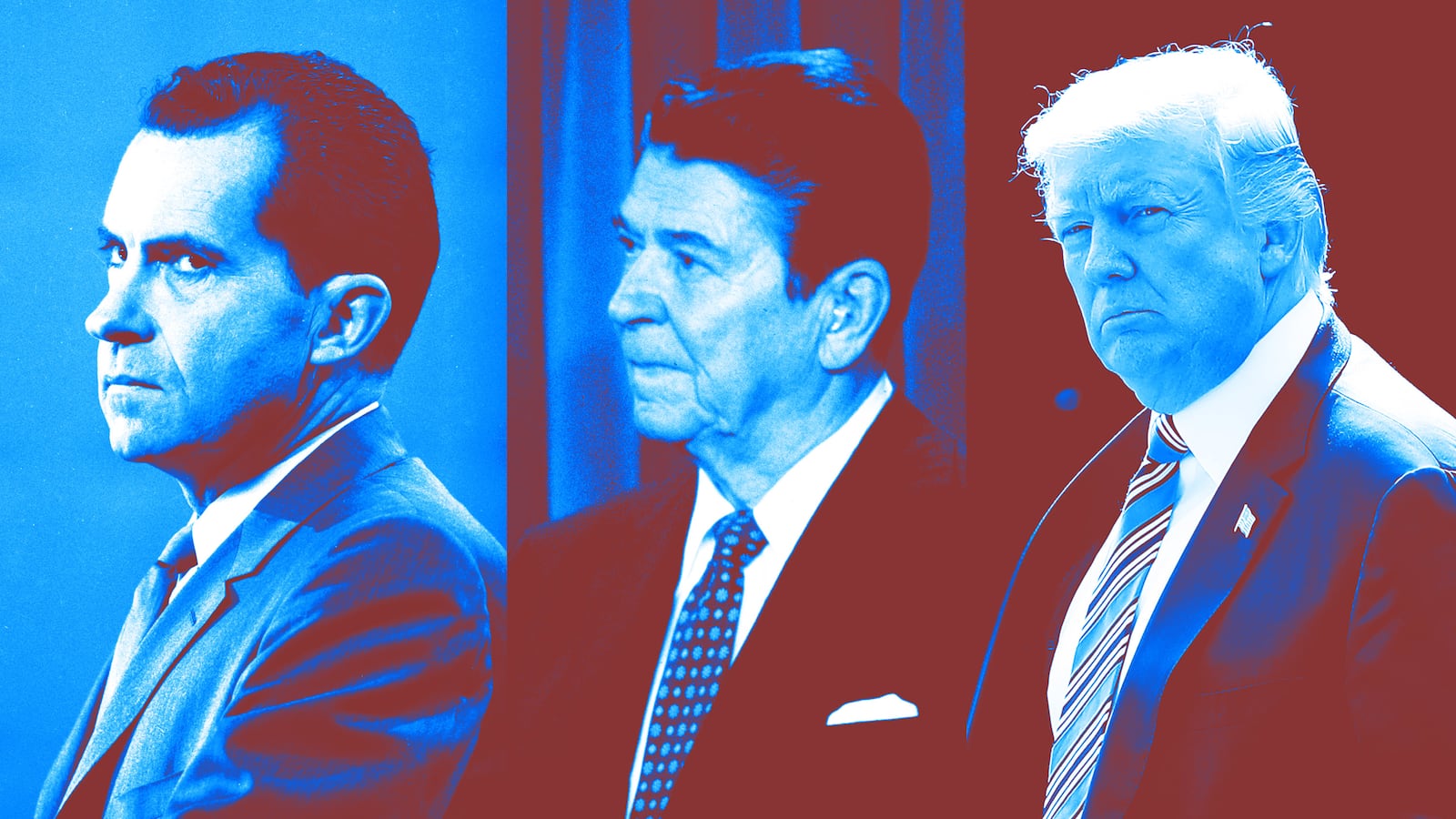I returned from my summer vacation touring Nazi headquarters in Munich and memorials to those they’d killed in Berlin hoping to understand new parallels between Adolf Hitler and Donald Trump.
Instead, I came back and better understood how much Trump is like Ronald Reagan. The 45th president doesn’t always rant and rave about racism; he sometimes speaks about racism more insidiously, like that one-time Hollywood actor, the “Great Communicator.”
Right before I left for Europe, there had been robust debates in the United States referring (accurately) to the locations where the U.S. concentrates large numbers of people in fetid conditions without access to due process as “concentration camps.” And as I toured sites memorializing how Jews, Roma, homosexuals, disabled people, and other “undesirables” had been detained and executed by the Third Reich, I was also viewing a distant horror show happening in U.S. news coverage.
Stories about congressional visits to our own concentration camps. Children dying in ICE custody. And—in the story that seemed to reverberate most loudly across the Atlantic— of Trump lashing out at four congresswomen of color that they should “go back” to where they came from. On the very day that I visited one of the 1936 Olympic stadiums, it was chilling to see a stadium of people in North Carolina on TV screaming “send her back!” about Congresswoman Ilhan Omar.
These stories registered somewhat differently for me in a city like Munich, where the Nazis first tried to take over Bavaria, and where the Munich Documentation Center has an unnerving show titled “The city without. Jews Foreigners Muslims Refugees,” which invites viewers to compare state terror of the 1930s with rising xenophobia today.
And so, after hearing story after story of the American president screaming on Twitter about his plan for a nation where congresswomen of color who fight back “go back”—and after visiting plazas and windows from which the Fuhrer himself had spewed his hateful words—I expected, upon watching Trump address his first rally last night since I returned, that I’d find myself searching for the obvious similarities.
Instead, I saw something much more familiar, mundane, and American. Trump sounded like Ronald Reagan Thursday night. He sounded like Richard Nixon.
Compared to his tone on Twitter, he wasn’t screaming in Ohio. He was relatively measured, muted, and almost boring. He was a plodding Republican. His call to xenophobia was calm. There were no “send her back” chants. As the American president at that rally, Trump trotted out a hokey character who dispenses the kinds of empty rhetoric that not only any Republican would use, but that half of the Democrats running for president would likely get behind—including frontrunner “Uncle Joe,” whose campaign Biden frames as a “battle for America’s soul.”
Like an effective emotional abuser, Trump knows how to swing between temperaments. According to one poll, his support rose after his “go back” tweets among Republicans; now, he has the chance to win over more mythical “Reagan Democrats” with a calm call to “Keep America Great”—the kind of empty American optimistic call like Barack Obama’s own (“America is already great”).
In Cincinnati, Trump came off like Reagan or Nixon: as a standard, racist, workaday Republican. It’s fitting he made this pivot this week, as there was much pearl clutching when a tape dropped of Reagan referring to people from Africa as “monkeys.” Reagan’s remark is in the same league as Nixon using anti-Semitic and anti-Mexican slurs on tape, or telling Henry Kissinger that he wanted to “bomb the living bejeezus out of North Vietnam” with a nuclear bomb.
But here’s the thing: you don’t need a tape of presidents to know they are being racist. The head of the American empire is, by default, going to be relying upon racist structures of power. Nixon’s and Reagan’s racist views about white and nonwhite people, at home and abroad, have been well documented in their policies and campaigns. So, too, have Trump’s racist views been documented for decades, such that needing Trump saying the n-word (on a tape that never materialized and probably doesn’t exist) is unnecessary.
Trump doesn’t have to speak crudely all the time for us to understand how dangerously he is leading the country and whipping up hysteria. When he speaks in the kinds of civil tones and bromides he used in Cincinnati (which might just win over David Brooks or Maureen Dowd), he is still peddling the same racist standard Republican politics as Reagan or Nixon—policies, as many African-American, Nicaraguan, or Vietnamese people can tell you, are deadly and racist enough.
Of course, Trump being Trump, he still said some crazy stuff, like that he was going to cure AIDS and end childhood cancer—pretty outrageous claims considering how anti-science his administration is, that federal scientists can’t even say the word “transgender” under his watch, how homophobic and transphobic his administration is, and so much more.
One need not go to Germany—or leave the United States at all—to find horror stories that compare with our current crisis. Indeed, as historian James Q. Whitman has written in Hitler’s American Model: The United States and the Making of Nazi Race Law, the Nazis weren’t merely stamped out by America during World War II; they looked to America in their rise. We have our own history of war and genocide. But it is exhausting and disorienting to keep trying to explain how dangerous this presidency is—and so, for a moment, I looked to Germany for some perspective.
But when I came home, I didn’t see a fascist at the podium; I saw President Trump, smugly echoing Reagan and Nixon and George W. Bush—and that was scary enough.






